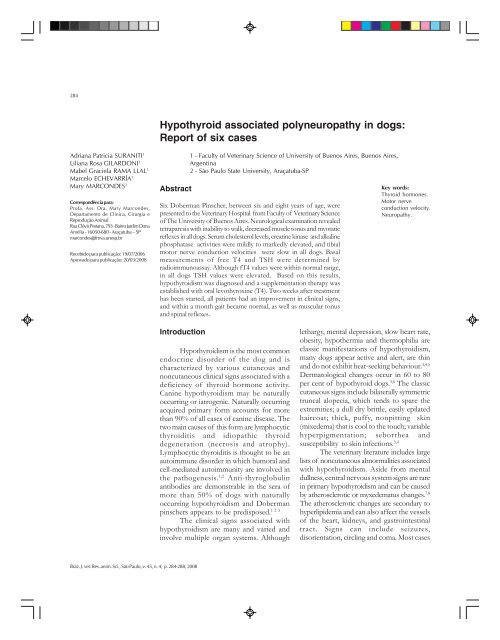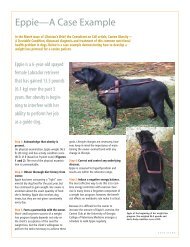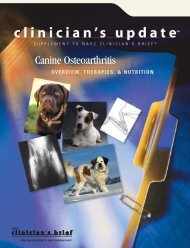Hypothyroid associated polyneuropathy in dogs ... - ResearchGate
Hypothyroid associated polyneuropathy in dogs ... - ResearchGate
Hypothyroid associated polyneuropathy in dogs ... - ResearchGate
- No tags were found...
You also want an ePaper? Increase the reach of your titles
YUMPU automatically turns print PDFs into web optimized ePapers that Google loves.
285have been reported <strong>in</strong> Doberman p<strong>in</strong>schers. 4A subcl<strong>in</strong>ical myopathy has beenreported <strong>in</strong> mature <strong>dogs</strong> with primaryhypothyroidism. 9,10 Occasionally, signs ofneuromuscular disorders can occur with orwithout cutaneous signs, and these <strong>in</strong>cludeweakness, stiffness, decreased consciousproprioception and muscle wast<strong>in</strong>g. 3,10,11 Theetiopathogenesis of this endocr<strong>in</strong>e myopathyis unknown. A disturbance <strong>in</strong> carbohydratemetabolism has been proposed to expla<strong>in</strong>the preferential type II fiber atrophy, whichoccurs <strong>in</strong> humans and can<strong>in</strong>e muscle. 10,11A hypothyroid-<strong>associated</strong> neuropathydoes appear to exist <strong>in</strong> mature to middleaged<strong>dogs</strong>, usually <strong>in</strong> large breeds, and maybe recognized without the usual signs ofhypothyroidism. 3,12,13 Peripheral neuropathiesmay also affect the cranial nerves caus<strong>in</strong>gabnormalities such as head tilt, facial nerveparalysis, strabismus, nystagmus, decreasedfacial sensitivity and laryngealparalysis. 3,7,14,15,16,17,18,19 Although thepathogenesis of this neuropathy is not clear,metabolic alterations would determ<strong>in</strong>eabnormalities <strong>in</strong> the transport axonal and <strong>in</strong>the functionality of Schwann cells. 3,7 Theearly stages are often missed because thesigns are mild. 13 The occurrence ofmegaesophagus, <strong>in</strong>termitent lameness,paraparesis and tetraparesis have all been<strong>associated</strong> with hypothyroidism. 14,15,18,19,20Cl<strong>in</strong>ical signs such as progressive weakness,muscle atrophy (ma<strong>in</strong>ly appendicular),hypotonia and depressed sp<strong>in</strong>al reflexes maybe seen. 11,17 Nerve fibers studies arecharacterized by both demyel<strong>in</strong>ationremyel<strong>in</strong>ationand axonal necrosis.Electrodiagnostic studies have revealedmultifocal patterns of fibrillation potentials,positive sharp waves and decreased motornerve conduction velocity. 3,11 This cl<strong>in</strong>icalsigns usually resolve with L-thyrox<strong>in</strong>e (T4)supplementation. Dogs improve rapidlywith<strong>in</strong> a few days after the start of treatment,and most <strong>dogs</strong> are neurologically normalafter one to two months of treatment. 3 Insome animals there is a lack of correlationbetween the degree of electromyographicabnormalities and the severity ofcl<strong>in</strong>ical signs. 20Results of hemogram, biochemicalpanel and ur<strong>in</strong>alysis may support a diagnosisof hypothyroidism and rule out otherdiseases. A mild nonregenerative anemia andfast<strong>in</strong>g hypercholesterolemia occur <strong>in</strong> 30 and75 per cent of hypothyroid <strong>dogs</strong>,respectively. Less common abnormalities<strong>in</strong>clude mild <strong>in</strong>creases <strong>in</strong> alkal<strong>in</strong>ephosphatase, alan<strong>in</strong>e am<strong>in</strong>otransferase andcreat<strong>in</strong>e k<strong>in</strong>ase. 6Despite the rout<strong>in</strong>e a regular use ofthyroid function tests <strong>in</strong> veter<strong>in</strong>ary medic<strong>in</strong>e,the practitioner is still plagued with theproblem of mak<strong>in</strong>g an accurate diagnosisof hypothyroidism. While <strong>in</strong> primaryhypothyroidism TSH levels should <strong>in</strong>creaseto stimulate the glands to produce morehormone, <strong>in</strong> secondary or tertiaryhypothyroidism levels are low. Because themajority of hypothyroid <strong>dogs</strong> have primarydisease, elevated TSH levels are to beexpected <strong>in</strong> most of them . To <strong>in</strong>crease thediscrim<strong>in</strong>at<strong>in</strong>g value of TSH, it has beensuggested that the assay be run <strong>in</strong> conjunctionwith TT4 or free T4 (fT4). In hypothyroidism4, 21the TT4 or fT4 would have to be low.Because not all laboratories may use the sameassay kit or technique to determ<strong>in</strong>e theirresults, normal ranges can vary fromlaboratory to laboratory. Values of TSH lessthan 0,5 ng/ml and from fT4 vary<strong>in</strong>g from0,3 to 1,7 ng/dl are considered diagnosticof hypothyroidism. 4 The present reportconcerns six cases of hypothyroid-<strong>associated</strong>pol<strong>in</strong>europathy <strong>in</strong> Doberman P<strong>in</strong>scher.Case ReportsSix Doberman P<strong>in</strong>scher (two malesand four females), between six and eight yearsof age, were presented to the Veter<strong>in</strong>aryHospital from Faculty of Veter<strong>in</strong>ary Scienceof The University of Buenos Aires withdiagnosis of Wobbler syndrome. Accord<strong>in</strong>gto the owners, the diagnosis was made basedon cl<strong>in</strong>ical signs and radiological studies ofcervical column with lateral <strong>in</strong>cidence and <strong>in</strong>forced flexion of the neck. The problem hasprogressed slowly, vary<strong>in</strong>g from one to threeBraz. J. vet. Res. anim. Sci., São Paulo, v. 45, n. 4, p. 284-288, 2008
286months and, accord<strong>in</strong>g to the owners, noone had thermophilia. Three females hadaltered estrous cycles. All of the <strong>dogs</strong>received dexamethasone without cl<strong>in</strong>icalimprovement <strong>in</strong> any of them. Physicalexam<strong>in</strong>ation revealed rectal temperaturewith<strong>in</strong> the normal range and normal sk<strong>in</strong> <strong>in</strong>all <strong>dogs</strong>. Only a male and a female werepresented with obesity. Neurologicalexam<strong>in</strong>ation revealed tetraparesis with<strong>in</strong>ability to walk, decreased muscle tonus andmyotatic reflexes <strong>in</strong> all <strong>dogs</strong>. Two of themalso presented disfonia.Complete blood counts (CBC) andbiochemical analysis were performed <strong>in</strong> all<strong>dogs</strong>. CBC, blood glucose concentrations,total prote<strong>in</strong>, album<strong>in</strong>, total calcium, ureanitrogen and creat<strong>in</strong><strong>in</strong>e concentrations as wellas plasma alan<strong>in</strong>e am<strong>in</strong>otransferase (ALT)and aspartate am<strong>in</strong>otransferase (AST) activitywere with<strong>in</strong> normal ranges <strong>in</strong> all <strong>dogs</strong>. Serumcholesterol levels were elevated <strong>in</strong> all <strong>dogs</strong>,with values rang<strong>in</strong>g from 292 to 504 mg/dl(Table 1). Serum creat<strong>in</strong>e k<strong>in</strong>ase and alkal<strong>in</strong>ephosphatase activities were mildly tomarkedly elevated <strong>in</strong> all <strong>dogs</strong>, with valuesrang<strong>in</strong>g from 160 to 1450 U/L and from180 to 460 U/L, respectively (Table 1).All <strong>dogs</strong> were submitted toelectroneurographic exam<strong>in</strong>ation of the tibialnerve. Tibial motor nerve conductionvelocities were slow <strong>in</strong> all <strong>dogs</strong>, vary<strong>in</strong>g from20 to 38m/s, when compared with normal<strong>dogs</strong>, which have velocities higher than 6022 23,24,25,26m/s.As the signs were compatible withhypothyroidism, basal measurements of freeT4 and TSH were determ<strong>in</strong>ed byradioimmunoassay us<strong>in</strong>g veter<strong>in</strong>ary kits.Although four from six <strong>dogs</strong> had fT4 valueswith<strong>in</strong> normal range, <strong>in</strong> all <strong>dogs</strong> TSH valueswere elevated (Table 1). Based on this results,hypothyroidism was suspected and asupplementation therapy was establishedwith oral levothyrox<strong>in</strong>e (T4), adjust<strong>in</strong>g thedose accord<strong>in</strong>g to each patient’s evolution,to confirm the diagnosis. Two weeks aftertreatment has been started, all patients hadan improvement <strong>in</strong> cl<strong>in</strong>ical signs, and with<strong>in</strong>two months thyroid function tests becamenormal, as well as gait, muscular tonus andsp<strong>in</strong>al reflexes.DiscussionAll <strong>dogs</strong> presented to the Veter<strong>in</strong>aryHospital had decreased muscle tonus andmyotatic reflexes <strong>in</strong> the four limbs, suggest<strong>in</strong>glower motor neuron <strong>in</strong>volvement. Manydiseases may cause signs of lower motorneuron <strong>in</strong>volvement and, among them,<strong>polyneuropathy</strong> <strong>associated</strong> withhypothyroidism which can be observed <strong>in</strong>Doberman P<strong>in</strong>schers. Peripheral neuropathyis the best documented neurologicmanifestation of hypothyroidism. DogsTable 1 - Blood chemical data (serum colesterol levels, creat<strong>in</strong>e k<strong>in</strong>ase and alkal<strong>in</strong>e phosphatase activities), tibialmotor nerve conduction velocities and free T4 ( fT4) and TSH basal measurements, <strong>in</strong> six DobermanP<strong>in</strong>scher suspected of hav<strong>in</strong>g hypothyroid-<strong>associated</strong> neuropathy. Buenos Aires, 2007Braz. J. vet. Res. anim. Sci., São Paulo, v. 45, n. 4, p. 284-288, 2008
287tipically present with exercise <strong>in</strong>tolerance,generalized weakness, ataxia andquadriparesis or paralysis. There is normallya slow progression of cl<strong>in</strong>ical signs frommild gait deficits to parapresis or tetraparesisobserved <strong>in</strong> most <strong>dogs</strong>. Neurologicexam<strong>in</strong>ation typically reveals proprioceptivedeficits of the pelvic and thoracic limbs, anddim<strong>in</strong>ished segmental reflexes. Mostcommonly all four limbs are affected;however, <strong>in</strong> some <strong>dogs</strong>, cl<strong>in</strong>ical signsprogress from the h<strong>in</strong>d limbs to theforelimbs or affect the h<strong>in</strong>d limbs alone. 3Dysfunctions of multiple cranial nerveshave been reported <strong>in</strong> hypothyroid <strong>dogs</strong>,and were observed <strong>in</strong> the two <strong>dogs</strong>with disfonia.Early reports suggested an associationbetween hypothyroidism and cervicalspondylomyelopathy, but this association islikely the result of a similar breedpredisposition for both disorders. Althoughcervical spondylopathy (Wobbler syndrome)is a neurologic disorder that appears withgreat frequency <strong>in</strong> Doberman p<strong>in</strong>schers, thedisease does not cause lower motor neuron<strong>in</strong>volvement. In most Doberman p<strong>in</strong>scherscl<strong>in</strong>ical signs develop between three and eightyears of age. They typically develop mildpelvic limb ataxia that progresses to severebilateral ataxia and hypermetria. Ataxia andparesis <strong>in</strong> the thoracic limbs may bepronounced <strong>in</strong> some cases but are sometimesdetected only by careful neurologicexam<strong>in</strong>ation. Some <strong>dogs</strong> have tetraparesis.Neurologic exam<strong>in</strong>ation evidences uppermotor neuron signs <strong>in</strong> the pelvic limbs(<strong>in</strong>crease muscle tonus and normal orexaggerate myotatic reflexes), and sometetraparetic <strong>dogs</strong> may have lower motorneuron signs <strong>in</strong> the thoracic limbs becauseof cervical gray matter <strong>in</strong>volvement. Thediagnosis of cervical spondylopathy isconfirmed by survey radiographys andmyelography.All of the six exam<strong>in</strong>ed <strong>dogs</strong> hadelevated serum cholesterol levels, creat<strong>in</strong>ek<strong>in</strong>ase and alkal<strong>in</strong>e phosphatase activities,besides slow tibial motor nerveconduction velocities which led us thoughtthat hypothyroidism was the cause of the<strong>polyneuropathy</strong>, suggested by hormonaldeterm<strong>in</strong>ations. It should be kept <strong>in</strong> m<strong>in</strong>dthat many affected animals do not haveobvious signs of hypothyroidism. Thereare several factors that make it hard todeterm<strong>in</strong>e the true relation betweenhypothyroidism and many of the lesscommon cl<strong>in</strong>ical associations attributed tothe disease. One factor is the challenge ofconfirm<strong>in</strong>g a diagnosis of hypothyroidism<strong>in</strong> <strong>dogs</strong>. Diagnosis of hypothyroidism ishampered by the lack of specificity ofthe thyrox<strong>in</strong>e assay as well as the lack ofsensitivity of the thyrothrop<strong>in</strong> assay. Inmany cases it is difficult to make adef<strong>in</strong>itive diagnosis and a therapeutic trialis necessary. In the present cases weconfirmed hypothyroidism withtherapeutic diagnosis.Pol<strong>in</strong>europatia associada a hipotireoidismo em cães: Relato de seis casosResumoSeis Dobermans P<strong>in</strong>scher, entre seis e oito anos de idade, foramencam<strong>in</strong>hados ao Hospital Veter<strong>in</strong>ário da Faculdade de CiênciasVeter<strong>in</strong>árias da Universidade de Buenos Aires. O exame neurológicorevelou tetraparesia com <strong>in</strong>capacidade para andar, dim<strong>in</strong>uição dotono muscular e de reflexos miotáticos em todos os cães. Os níveisde colesterol, creat<strong>in</strong>a qu<strong>in</strong>ase e fosfatase alcal<strong>in</strong>a encontravam-se demoderada a acentuadamente elevados. As velocidades de conduçãonervosa do nervo tibial estavam dim<strong>in</strong>uídas em todos os cães. Osníveis séricos basais de T4 livre e TSH foram determ<strong>in</strong>ados porradioimunoensaio e, embora os valores de T4 livre estivessem dentrodos limites de normalidade, em todos os cães o TSH estava elevado.Palavras-chave:Hormônios tireoidianos.Velocidade de conduçãonervosa motora.Neuropatia.Braz. J. vet. Res. anim. Sci., São Paulo, v. 45, n. 4, p. 284-288, 2008
288Baseado nestes resultados, diagnosticou-se hipotireoidismo e <strong>in</strong>iciouseuma suplementação oral com levotirox<strong>in</strong>a (T4). Duas semanasapós o <strong>in</strong>ício do tratamento todos os pacientes tiveram melhora clínicae, dentro de um mês a locomoção, o tono muscular e os reflexosmedulares tornaram-se normais.References1 GRAHAM, P. A.; REFSAL, K. R.; NACHREINER, R.F. Etiopathologic f<strong>in</strong>d<strong>in</strong>gs of can<strong>in</strong>e hypothyroidism.Vet. Cl<strong>in</strong>. Small Anim., v. 37, n. 4, p. 617-631, 2007.2 BEALE, K. M.; HALLIWELL, R. E.; CHEN, C. L.Prevalence of antithyroglobul<strong>in</strong> antibodies detected byenzyme-l<strong>in</strong>ked immunosorbent assay of can<strong>in</strong>e serum.J. Am. Vet. Med. Assoc., v. 196, n. 5, p. 745-748,1990.3 SCOTT-MONCRIEFF, J. C. Cl<strong>in</strong>ical signs andconcurrent diseases of hypothyroidism <strong>in</strong> <strong>dogs</strong> and cats.Vet. Cl<strong>in</strong>. Small Anim., v. 37, n. 4, p. 709-722, 2007.4 SCOTT, D. W.; MILLER, W. H.; GRIFFIN, C. E. Smallanimal dermatology. 6 th ed. Philadelphia:W.B.Saunders, 2001. 1528 p.5 DIXON, R. M.; REID, S. W.; MOONEIJ, C. T.Epidemiological, cl<strong>in</strong>ical, haematological andbiochemical characteristics of can<strong>in</strong>e hypothyroidism .Vet. Rec., v. 145, n. 17, p. 481-487, 1999.6 SCOTT-MONCRIEFF, J. C. R.; GUPTILL-YORAN, L.<strong>Hypothyroid</strong>ism. In: ETTINGER, S. J.; FELDMAN, E. C.Textbook of veter<strong>in</strong>ary <strong>in</strong>ternal medic<strong>in</strong>e. 5 th ed.Philadelphia: Saunders, 2000. p. 1419-1429.7 PANCIERA, D. L. Conditions <strong>associated</strong> with can<strong>in</strong>ehypothyroidism. Vet. Cl<strong>in</strong>. North Am. Small Anim.Pract., v. 31, n. 5, p. 935-950, 2001.8 PATTERSON J. S.; RUSLEY, M. S.; ZADAREJ, J. F.Neurologic manifestations of cerebrovascularatherosclerosis <strong>associated</strong> with primary hypothyroidism<strong>in</strong> a dog. J. Am. Vet. Med. Assoc., v. 186, n. 5, p. 499-503, 1985.9 BRAUND, K. G. Cl<strong>in</strong>ical syndromes <strong>in</strong> veter<strong>in</strong>aryneurology. 2 nd ed. St. Louis: Mosby, 1994. 477 p.10 BRAUND, K. G. Degenerative causes ofneuropathies <strong>in</strong> <strong>dogs</strong> and cats. Veter<strong>in</strong>ary Medic<strong>in</strong>e, v.91, n. 8, p. 722-739, 1996.11 BRAUND, K. G.; DILLON, A. R.; AUGUST, J. R.;GANJAM, J. K. <strong>Hypothyroid</strong> myopathy <strong>in</strong> two <strong>dogs</strong>.Vet. Pathol., v. 18, n. 5. p. 589-598, 1981.12 HIGGINS, M. A.; ROSSMEISL JUNIOR, J. H.;PANCIERA, D. L. <strong>Hypothyroid</strong>-<strong>associated</strong> centralvestibular disease <strong>in</strong> 10 <strong>dogs</strong>: 1999-2005. J. Vet. Intern.Med., v. 20, n. 6, p. 1363-1369, 2006.13 LORENZ, M. D.; KORNEGAY, J. N. Handbook ofveter<strong>in</strong>ary neurology. 4 th ed. Philadelphia: W.B.Saunders, 2004. 468 p.14 BICHSEL, P.; JACOBS, G.; OLIVER JUNIOR, J. E.Neurologic manifestations <strong>associated</strong> withhypothyroidism <strong>in</strong> four <strong>dogs</strong>. J. Am. Vet. Med. Assoc.,v. 192, n. 12, p. 1745-1747, 1988.15 BUDSBERG, S. C.; MOORE, G. E.;KLAPPENHACH, K. Thyrox<strong>in</strong>-responsive unilateralforelimb lameness and generalized neuromusculardisease <strong>in</strong> four hypothyroid <strong>dogs</strong>. J. Am. Vet. Med.Assoc., v. 202, n. 11, p. 1859-1860, 1993.16 CHRISMAN, C. L. Problems <strong>in</strong> small animalneurology. 2 nd ed. Philadelphia: Lea & Febiger, 1991.17 CHRISMAN, C. L. Polyneropathies of cats. SmallAnim. Pract., v. 41, n. 9, p. 384-389, 2000.18 GABER, C. E.; AMIS, T. C.; LeCOUTEUR, R. A.Laryngeal paralysis <strong>in</strong> <strong>dogs</strong>: a review of 23 cases. J. Am.Vet. Med. Assoc., v. 186, n. 4, p. 377-380, 1985.19 JAGGY, A.; OLIVER, J. E.; FERGUSON, D. C.;MAHAFFEY, E. A.; GLAUS JR, T. Neurologicmanifestations of hypothyroidism: a retrospective studyof 29 <strong>dogs</strong>. J. Vet. Intern. Med., v. 8, n. 5, p. 328-336,1994.20 INDRIERI, R. J.; WHALEN, L. R.; CARDINET, G.H.; HOLLIDAY, T. A. Neuromuscular abnormalities<strong>associated</strong> with hypothyroidism and lymphocyticthyroiditis <strong>in</strong> three <strong>dogs</strong>. J. Am. Vet. Med. Assoc., v.190, n. 5, p. 544-548, 1987.21 FERGUSON, D. C. Test<strong>in</strong>g for hypothyroidism <strong>in</strong><strong>dogs</strong>. Vet. Cl<strong>in</strong>. Small Anim., v. 37, n. 4, p. 647-669,2007.22 CHRISMAN, C. L.; CLEMMONS, R. M.Electrodiagnostic test<strong>in</strong>g. In: BOJRAB, M. J. Diseasemechanisms <strong>in</strong> small animal surgery. 2 nd ed. Philadelphia:Lea & Febiger, 1993. p. 1183-1201.23 DAVIS, P. E.; MALIK, R. Motor nerve conductionand sp<strong>in</strong>al reflex measurements as predictors of rac<strong>in</strong>gperformance <strong>in</strong> greyhounds. Aust. Vet. J., v. 71, n. 1, p.24-25, 1994.24 DUNCAN, I. D. Peripheral nerve disease <strong>in</strong> the dogand cat. Vet. Cl<strong>in</strong>. North Am. - Small Anim. Pract., v.10, n. 1, p. 177-211, 1980.25 FEITOSA, M. M.; LARSSON, M. H. M. A.;USHIKOSHI, W. S.; PERRI, S. H. V. Determ<strong>in</strong>ação davelocidade de condução nervosa motora dos nervostibial e peroneal de cães cl<strong>in</strong>icamente sadios. ArsVeter<strong>in</strong>ária, v. 16, n. 2, p. 83-91, 2000.26 MALIK, R.; HO, S.; CHURCH, D. B. A new methodfor record<strong>in</strong>g and analys<strong>in</strong>g evoked motor potentialsfrom <strong>dogs</strong>. Small Anim. Pract., v. 30, n. 1, p. 13-19,1989.Braz. J. vet. Res. anim. Sci., São Paulo, v. 45, n. 4, p. 284-288, 2008








